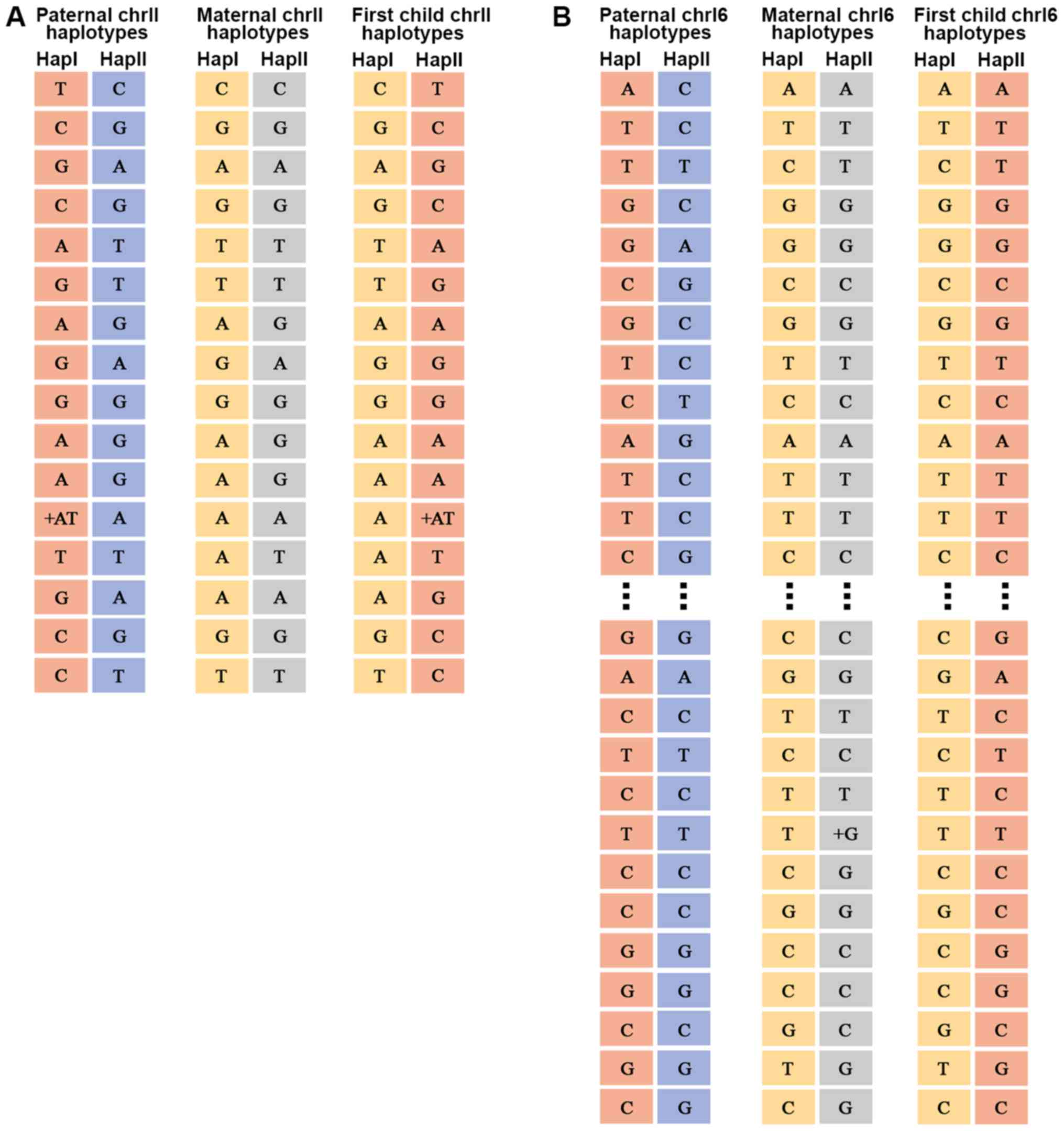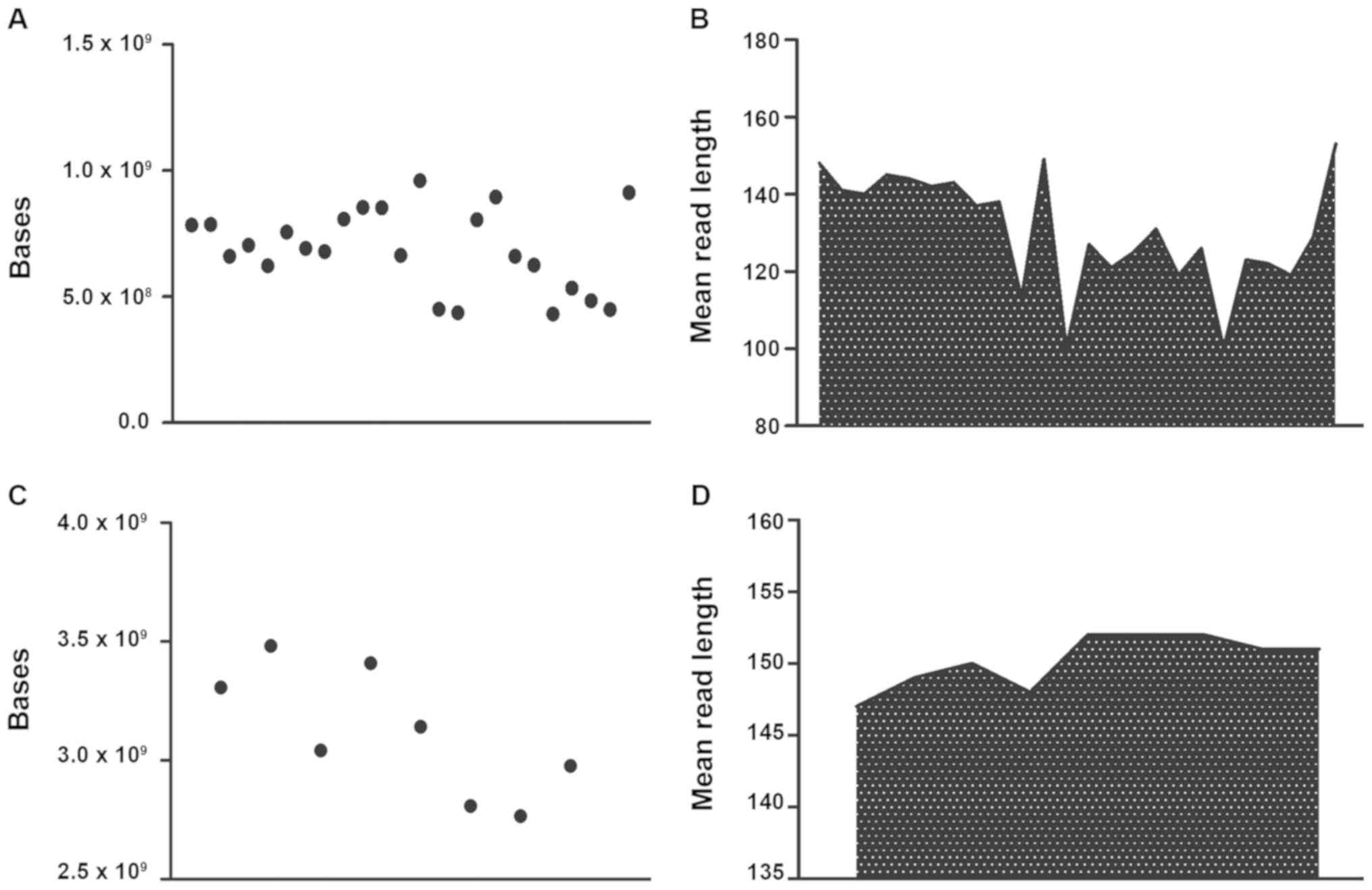|
1
|
Higgs DR, Engel JD and Stamatoyannopoulos
G: Thalassaemia. Lancet. 379:373–383. 2012. View Article : Google Scholar : PubMed/NCBI
|
|
2
|
Pan HF, Long GF, Li Q, Feng YN, Lei ZY,
Wei HW, Huang YY, Huang JH, Lin N, Xu QQ, et al: Current status of
thalassemia in minority populations in Guangxi, China. Clin Genet.
71:419–426. 2007. View Article : Google Scholar : PubMed/NCBI
|
|
3
|
Lo YM, Chan KC, Sun H, Chen EZ, Jiang P,
Lun FM, Zheng YW, Leung TY, Lau TK, Cantor CR and Chiu RW: Maternal
plasma DNA sequencing reveals the genome-wide genetic and
mutational profile of the fetus. Sci Transl Med. 2:61ra912010.
View Article : Google Scholar : PubMed/NCBI
|
|
4
|
Yin A, Li B, Luo M, Xu L, Wu L, Zhang L,
Ma Y, Chen T, Gao S, Liang J, et al: The prevalence and molecular
spectrum of α- and β-globin gene mutations in 14,332 families of
Guangdong province, China. PLoS One. 9:e898552014. View Article : Google Scholar : PubMed/NCBI
|
|
5
|
Cao A and Kan YW: The prevention of
thalassemia. Cold Spring Harb Perspect Med. 3:a117752013.
View Article : Google Scholar
|
|
6
|
Mourad FH, Hoffbrand AV, Sheikh-Taha M,
Koussa S, Khoriaty AI and Taher A: Comparison between
desferrioxamine and combined therapy with desferrioxamine and
deferiprone in iron overloaded thalassaemia patients. Br J
Haematol. 121:187–189. 2003. View Article : Google Scholar : PubMed/NCBI
|
|
7
|
Lidonnici MR and Ferrari G: Gene therapy
and gene editing strategies for hemoglobinopathies. Blood Cells Mol
Dis. 70:87–101. 2018. View Article : Google Scholar : PubMed/NCBI
|
|
8
|
Allyse M, Minear M, Rote M, Hung A,
Chandrasekharan S, Berson E and Sridhar S: Non-invasive prenatal
testing: A review of international implementation and challenges.
Int J Women's Health. 7:113–126. 2015. View Article : Google Scholar
|
|
9
|
Mujezinovic F and Alfirevic Z:
Procedure-relatedcomplications of amniocentesis and chorionic
villous sampling: A systematic review. Obstet Gynecol. 110:687–694.
2007. View Article : Google Scholar : PubMed/NCBI
|
|
10
|
Lo YM, Corbetta N, Chamberlain PF, Rai V,
Sargent IL, Redman CW and Wainscoat JS: Presence of fetal DNA in
maternal plasma and serum. Lancet. 350:485–487. 1997. View Article : Google Scholar : PubMed/NCBI
|
|
11
|
Babkina N and Graham JM: New genetic
testing in prenatal diagnosis. Semin Fetal Neonatal Med.
19:214–219. 2014. View Article : Google Scholar : PubMed/NCBI
|
|
12
|
Chiu RW, Akolekar R, Zheng YW, Leung TY,
Sun H, Chan KC, Lun FM, Go AT, Lau ET, To WW, et al: Non-invasive
prenatal assessment of trisomy 21 by multiplexed maternal plasma
DNA sequencing: Large scale validity study. BMJ. 342:c74012011.
View Article : Google Scholar : PubMed/NCBI
|
|
13
|
You Y, Sun Y, Li X, Li Y, Wei X, Chen F,
Ge H, Lan Z, Zhu Q, Tang Y, et al: Integration of targeted
sequencing and NIPT into clinical practice in a Chinese family with
maple syrup urine disease. Genet Med. 16:594–600. 2014. View Article : Google Scholar : PubMed/NCBI
|
|
14
|
McCullough RM, Almasri EA, Guan X, Geis
JA, Hicks SC, Mazloom AR, Deciu C, Oeth P, Bombard AT, Paxton B, et
al: Non-invasive prenatal chromosomal aneuploidy testing-clinical
experience: 100,000 clinical samples. PLoS One. 9:e1091732014.
View Article : Google Scholar : PubMed/NCBI
|
|
15
|
Li Y, Zimmermann B, Rusterholz C, Kang A,
Holzgreve W and Hahn S: Size separation of circulatory DNA in
maternal plasma permits ready detection of fetal DNA polymorphisms.
Clin Chem. 50:1002–1011. 2004. View Article : Google Scholar : PubMed/NCBI
|
|
16
|
Chan KC, Zhang J, Hui AB, Wong N, Lau TK,
Leung TN, Lo KW, Huang DW and Lo YM: Size distributions of maternal
and fetal DNA in maternal plasma. Clin Chem. 50:88–92. 2004.
View Article : Google Scholar : PubMed/NCBI
|
|
17
|
Hui WW, Jiang P, Tong YK, Lee WS, Cheng
YK, New MI, Kadir RA, Chan KC, Leung TY, Lo YM and Chiu RW:
Universal haplotype-based noninvasive prenatal testing for single
gene diseases. Clin Chem. 63:513–524. 2017. View Article : Google Scholar : PubMed/NCBI
|
|
18
|
Xu Y, Li X, Ge H, Xiao B, Zhang Y, Ying X,
Pan X, Wang L, Xie W, Ni L, et al: Haplotype-based approach for
noninvasive prenatal tests of Duchenne muscular dystrophy using
cell-free fetal DNA in maternal plasma. Genet Med. 17:889–896.
2015. View Article : Google Scholar : PubMed/NCBI
|
|
19
|
Ma D, Ge H, Li X, Jiang T, Chen F, Zhang
Y, Hu P, Chen S, Zhang J, Ji X, et al: Haplotype-based approach for
noninvasive prenatal diagnosis of congenital adrenal hyperplasia by
maternal plasma DNA sequencing. Gene. 544:252–258. 2014. View Article : Google Scholar : PubMed/NCBI
|
|
20
|
Lo YM, Hjelm NM, Fidler C, Sargent IL,
Murphy MF, Chamberlain PF, Poon PM, Redman CW and Wainscoat JS:
Prenatal diagnosis of fetal RhD status by molecular analysis of
maternal plasma. N Engl J Med. 339:1734–1738. 1998. View Article : Google Scholar : PubMed/NCBI
|
|
21
|
Saito H, Sekizawa A, Morimoto T, Suzuki M
and Yanaihara T: Prenatal DNA diagnosis of a single-gene disorder
from maternal plasma. Lancet. 356:11702000. View Article : Google Scholar : PubMed/NCBI
|
|
22
|
Amicucci P, Gennarelli M, Novelli G and
Dallapiccola B: Prenatal diagnosis of myotonic dystrophy using
fetal DNA obtained from maternal plasma. Clin Chem. 46:301–302.
2000. View Article : Google Scholar : PubMed/NCBI
|
|
23
|
González-González MC, Trujillo MJ,
Rodríguez de Alba M, García-Hoyos M, Lorda-Sánchez I, Díaz-Recasens
J, Ayuso C and Ramos C: Huntington disease-unaffected fetus
diagnosed from maternal plasma using QF-PCR. Prenatal Diag.
23:232–234. 2003. View
Article : Google Scholar : PubMed/NCBI
|
|
24
|
Lam KW, Jiang P, Liao GJ, Chan KC, Leung
TY, Chiu RW and Lo YM: Noninvasive prenatal diagnosis of monogenic
diseases by targeted massively parallel sequencing of maternal
plasma: Application to β-Thalassemia. Clin Chem. 58:1467–1475.
2012. View Article : Google Scholar : PubMed/NCBI
|
|
25
|
Camunas-Soler J, Lee H, Hudgins L, Hintz
SR, Blumenfeld YJ, El-Sayed YY and Quake SR: Noninvasive prenatal
diagnosis of single-gene disorders by use of droplet digital PCR.
Clin Chem. 64:336–345. 2018. View Article : Google Scholar : PubMed/NCBI
|
|
26
|
Hudecova I and Chiu RW: Non-invasive
prenatal diagnosis of thalassemias using maternal plasma cell free
DNA. Best Pract Res Clin Obstet Gynaecol. 39:63–73. 2017.
View Article : Google Scholar : PubMed/NCBI
|
|
27
|
Wenke L, Fengyu L, Siyao Z, Bin C, Na Z,
Yu N, Dao Z and Qian Z: Automatic analysis pipeline of
next-generation sequencing data. Yi Chuan. 36:618–624. 2014.(In
Chinese). PubMed/NCBI
|
|
28
|
De Summa S, Malerba G, Pinto R, Mori A,
Mijatovic V and Tommasi S: GATK hard filtering: Tunable parameters
to improve variant calling for next generation sequencing targeted
gene panel data. BMC Bioinformatics. 18 (Suppl 5):S1192017.
View Article : Google Scholar
|
|
29
|
Bauer DC: Variant calling comparison
CASAVA1.8 and GATK. Nat Prec. 18–Jul;2011.doi:
10.1038/npre.2011.6107.1. View Article : Google Scholar
|
|
30
|
Lo YM, Lun FM, Chan KC, Tsui NB, Chong KC,
Lau TK, Leung TY, Zee BC, Cantor CR and Chiu RW: Digital PCR for
the molecular detection of fetal chromosomal aneuploidy. Proc Natl
Acad Sci USA. 104:13116–13121. 2007. View Article : Google Scholar : PubMed/NCBI
|
|
31
|
Meng M, Li X, Ge H, Chen F, Han M, Zhang
Y, Kang D, Xie W, Gao Z, Pan X, et al: Noninvasive prenatal testing
for autosomal recessive conditions by maternal plasma sequencing in
a case of congenital deafness. Genet Med. 16:972–976. 2014.
View Article : Google Scholar : PubMed/NCBI
|
|
32
|
Allen S, Young E and Bowns B: Noninvasive
prenatal diagnosis for single gene disorders. Curr Opin Obstet
Gynecol. 29:73–79. 2017. View Article : Google Scholar : PubMed/NCBI
|
|
33
|
Walsh JM and Goldberg JD: Fetal aneuploidy
detection by maternal plasma DNA sequencing: A technology
assessment. Prenatal Diag. 33:514–520. 2013. View Article : Google Scholar : PubMed/NCBI
|
|
34
|
Galbiati S, Monguzzi A, Damin F, Soriani
N, Passiu M, Castellani C, Natacci F, Curcio C, Seia M, Lalatta F,
et al: COLD-PCR and microarray: Two independent highly sensitive
approaches allowing the identification of fetal paternally
inherited mutations in maternal plasma. J Med Genet. 53:481–487.
2016. View Article : Google Scholar : PubMed/NCBI
|
|
35
|
Langlois S and Brock J; Genetics
Committee, : Current status in non-invasive prenatal detection of
down syndrome, trisomy 18, and trisomy 13 using cell-Free DNA in
Maternal Plasma. J Obstetr Gynaecol Can. 35:177–181. 2013.(In
English, French). View Article : Google Scholar
|
|
36
|
Benn P, Borrell A, Chiu RW, Cuckle H,
Dugoff L, Faas B, Gross S, Huang T, Johnson J, Maymon R, et al:
Position statement from the chromosome abnormality screening
committee on behalf of the board of the international society for
prenatal diagnosis. Prenatal Diag. 35:725–734. 2015. View Article : Google Scholar : PubMed/NCBI
|
|
37
|
Gregg AR, Gross SJ, Best RG, Monaghan KG,
Bajaj K, Skotko BG, Thompson BH and Watson MS: ACMG statement on
noninvasive prenatal screening for fetal aneuploidy. Genet Med.
15:395–398. 2013. View Article : Google Scholar : PubMed/NCBI
|
|
38
|
Xiong L, Barrett AN, Hua R, Tan TZ, Ho SS,
Chan JK, Zhong M and Choolani M: Non-invasive prenatal diagnostic
testing for β-thalassaemia using cell-free fetal DNA and
next-generation sequencing. Prenat Diagn. 35:258–265. 2014.
View Article : Google Scholar : PubMed/NCBI
|
|
39
|
Yan TZ, Mo QH, Cai R, Chen X, Zhang CM,
Liu YH, Chen YJ, Zhou WJ, Xiong F and Xu XM: Reliable detection of
paternal SNPs within deletion breakpoints for non-invasive prenatal
exclusion of homozygous α-thalassemia in maternal plasma. PLoS One.
6:e247792011. View Article : Google Scholar : PubMed/NCBI
|
|
40
|
Ho SS, Chong SS, Koay ES, Ponnusamy S,
Chiu L, Chan YH, Rauff M, Baig S, Chan J, Su LL, et al: Noninvasive
prenatal exclusion of haemoglobin Bart's using foetal DNA from
maternal plasma. Prenat Diagn. 30:65–73. 2010.PubMed/NCBI
|
|
41
|
Devers PL, Cronister A, Ormond KE, Facio
F, Brasington CK and Flodman P: Noninvasive prenatal
Testing/Noninvasive prenatal diagnosis: The Position of the
National Society of Genetic Counselors. J Genet Couns. 22:291–295.
2013. View Article : Google Scholar : PubMed/NCBI
|
|
42
|
Lee ST, Weykamp CW, Lee YW, Kim JW and Ki
CS: Effects of 7 hemoglobin variants on the measurement of
glycohemoglobin by 14 analytical methods. Clin Chem. 53:2202–2205.
2007. View Article : Google Scholar : PubMed/NCBI
|
|
43
|
Yang X, Zhou Q, Zhou W, Zhong M, Guo X,
Wang X and Fan X: A Cell-free DNA Barcode-enabled single-molecule
test for noninvasive prenatal diagnosis of monogenic disorders:
Application to β-thalassemia. Adv Sci. 6:18023322019. View Article : Google Scholar
|
|
44
|
Fan DM, Yang X, Huang LM, Ouyang GJ, Yang
XX and Li M: Simultaneous detection of target CNVs and SNVs of
thalassemia by multiplex PCR and nextgeneration sequencing. Mol Med
Rep. 19:2837–2848. 2019.PubMed/NCBI
|

















